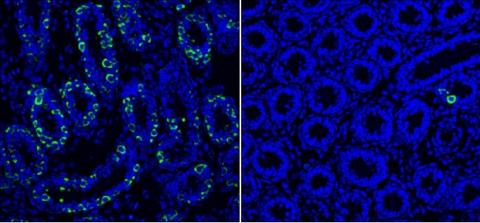A single protein regulates a battery of key genes inside developing sperm, according to a new study out of Case Western Reserve University School of Medicine. Scientists discovered the protein—called Dazl—controls a network of genes essential for developing sperm to replicate and survive. The findings, published in Cell Reports, could lay the groundwork for future research into therapies for infertile men.
“While Dazl was known to be very important for fertility and reproductive health, its actual role inside cells was poorly understood” said the study’s first author, Leah Zagore, graduate student at Case Western Reserve University. Zagore’s research showed Dazl physically attaches to 2,290 RNAs inside germ cells—progenitor cells that ultimately grow into sperm.
Germ cells are extraordinary—they become sperm and eggs and ultimately an organism’s progeny. Male germ cells in particular must replicate again and again over the course of a man’s life. “This specialized cell requires unique regulation and control of gene expression,” said Zagore “Dazl functions as a master regulator. It promotes the correct levels of other proteins that, in turn, control many essential processes within growing sperm, including proliferation and cell survival.”
Although Dazl binds to thousands of RNAs, not every interaction is meaningful, say the researchers. “Dazl binds a very simple sequence in RNA, a string of three RNA bases (G-U-U), which occurs all over RNA fragments. But we found G-U-Us that are directly bound by Dazl are highly concentrated in a specific spot on RNAs,” said Zagore’s advisor Donny Licatalosi, PhD, assistant professor in the Center for RNA Science and Therapeutics at Case Western Reserve University School of Medicine. “This spot occurs right before the ‘polyA tail’ found at the end of nearly all messenger RNAs, which are templates to make proteins.”
This highly restricted pattern indicates the polyA tail is a key determinant in where Dazl binds. It functions as part of a general delivery mechanism that loads Dazl onto thousands of different mRNAs. Surprisingly, only a subset of the RNAs that have Dazl binding (~22%) seem to be regulated by it. The delivery strategy is broad so that many RNAs are loaded with Dazl, but only for a subset of RNAs does this interaction lead directly to positive gene regulation. Said Licatalosi, “You could think about it as a mass marketing campaign with only a handful of responders whose opinions really count.” Many RNAs in the subset of regulated genes encode cell cycle proteins – placing Dazl in a central role regulating cell proliferation in developing sperm.
The work was a collaborative effort involving Columbia University and many Case Western Reserve core facilities, including the Cytometry and Microscopy Core, Genomics Core, and Transgenic and Targeting Facility. “It’s only through combining fluorescent labeling of cells, flow cytometry, and multiple RNA profiling and mapping tools, that we can put the pieces together to answer longstanding questions about Dazl’s role in germ cell survival,” said Licatalosi. “We now have a better understanding of molecular events that ensure survival of germ cells.” Added Zagore, “Study of Dazl may also give us a better understanding of the pathways controlling cell cycle regulation and the mechanisms used to coordinate RNA networks.”
###
This work was supported by funds from the National Institutes of Health to L.L.Z. (T32 GM08056) and D.D.L. (R01 GM107331).
Zagore L, et al. “Dazl regulates germ cell survival through a network of polyA-proximal mRNA interactions.” Cell Reports.
For more information about Case Western Reserve University School of Medicine, please visit: case.edu/medicine.
Media Contact(s):
Ansley Gogol
Case Western Reserve University
School of Medicine
Office: 216-368-4452
Ansley.Gogol@case.edu


